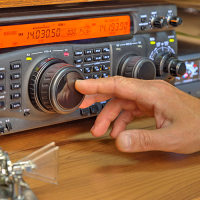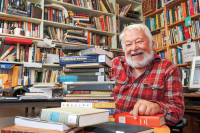Petal to the metal: Franklin metal artist Victor Raul Moraloza grows in art as in life
By Michael Beadle
For Victor Raul Moraloza, each day is a gift.
From being a high school wrestling champion to surviving a grenade explosion in the Vietnam War to treasure diving off the coast of Colombia to creating award-winning metal sculptures that are sold all over the United States, Moraloza has always been willing to take that gift and do what he could with it.
Walking through the art studio at his home outside Franklin, there’s a garden of metal sculptures in constant bloom. There are red maple branches, lily pad fountains, winding vines, prickly cactus plants, roses, and orchids — all made of copper and wiring.
“I do about eight different types of orchids,” he says.
Related Items
One of his masterpieces is a finely crafted eagle with a four-foot wingspan and scores of copper feathers painstakingly pieced together. The eagle won second place in the 2003 National Veterans Creative Arts Program, which featured some 1,200 entries in the competition.
Perhaps his greatest compliment came when he was taking photos of his blooming golden barrel cactus sculpture outside his home. A hummingbird zipped down and momentarily thought to poke its beak in the red-orange bloom.
“That blew me away when the bird tried to get nectar from it,” he said.
Without any formal training, Moraloza has become a much sought-after artist designing fountains, centerpieces, wall hangings and decorative flowers out of copper and wire tubing for people all over the United States. He ships his art to Illinois, Texas, Wisconsin, Florida, Kentucky and Tennessee.
Sometimes, he visits a client’s home to get the basic idea of what customer wants. Sometimes, they come to his house, a renovated homestead cabin on a quiet, wooded hill outside of Franklin. Moraloza built his own studio, surrounding it with windows to give it plenty of light like a sunroom for inspiring views of wildflowers and trees around his property that often make their way into his artwork.
“This is what I wanted,” Moraloza says, admiring the peace of his surroundings. “There’s nothing like living a simple, stress-free life and trying to live closer to God.”
The studio is full of plants — both metal and real. There’s a tidy desk for his tools. On the wall are coils of wire, more plants, pictures of family, a portrait of Chief Joseph, and a bright geometric design of an Incan tapestry. Two squawking macaws — Tiki and Javier — perch in a large cage in the back.
From shrapnel to roses
Growing up in Denver, Colo., Moraloza was a champion high school wrestler aiming to make the 1968 Olympic team, but Uncle Sam had different plans. The Vietnam War was raging, and Moraloza got drafted along with four of his brothers. On his last mission just before his tour ended, he was near a landing zone and tripped a grenade-studded wire that blew away parts of his right side.
Despite receiving about a dozen medals including two Purple Hearts and a Bronze Star, Moraloza found his military service disheartening. He wound up disillusioned by government lies and got caught in the Veterans Administration bureaucracy waiting for benefits as a disabled veteran. Medical operations have replaced both knees and repaired wounds on his leg and upper torso. It took years to heal from his wounds — both physically and emotionally. Even more than 30 years after that exploding grenade, he can still replay the scene in his mind.
Although metal tore apart his body, he learned to work with metal as a welder for 20 years.
He was living in Denver in 1991 when he saw a job listing in a magazine about an expedition off the coast of Colombia that was searching for the lost treasure of a 1602 Spanish fleet. Having been a diver, he took the job. After the expedition, Moraloza landed in Western North Carolina, not far from where the expedition’s archeologist lived.
Struggling to make ends meet with meager veteran benefits and then learning that his daughter, Lucia, had cancer as a result of what Moraloza thinks were complications from taking synthetic estrogen, life looked like it couldn’t get any worse.
Then one day, a friend gave him some copper. Moraloza began twisting it, bending it, shaping it into a trillium flower. It would become the first of many flowers he created and eventually started selling. Moraloza discovered a talent he never knew he had. He poured his love, his pain, his memories into these copper creations — and that’s what he came to call his new business: Copper Creations.
Meanwhile, Lucia’s cancer went into remission. She’s now a 4.0 student at the Denver Police Academy training to become a detective.
From creating copper flowers, Moraloza began making animals — a sea turtle, a heron, an eagle, a rattlesnake. He made spider webs, magnolia and rhododendron blooms, ferns, morning glories, bamboo shoots, and even a crown of thorns.
One design for a retired Navy officer was a six-and-a-half-foot long banana leaf light fixture. The roses he still does are a tribute to his daughter Lucia’s favorite flower.
A one-man operation
The range of artwork varies, but Moraloza generally does about two or three pieces per month.
“I’m a one-man operation,” Moraloza says. “It’s not your regular 8 to 4 job.”
He’ll often start working on a project in the evening, take periodic breaks, and continue on through the quiet hours of the morning.
He often knows exactly what the piece will look like before it’s done. In his mind, he sees the piece inside out. He can flip it and move it around in his imagination.
“At times my head would hurt — I had so many designs,” he says.
Shaping coils and sheets of copper into timeless works of art can be tiring on the shoulders and spine, Moraloza explains, and it’s tough standing on a pair of reconstructed knees. At times, he has to hold the welding torch in his mouth, so he can free his hands to piece parts together as the metal heats and bends.
He starts with flat sheets of copper, and traces lines where he’ll cut the copper into shapes of leaves, feathers, stems, or other components. Then, he cuts the copper and heats it with a blowtorch to bend the metal and shape it with chisels, hammers and pliers. Afterwards, he’ll heat it some more to give it a warm metallic luster. Since he’s not yet comfortable with painting the metal, he dabs various acids on a piece to get just the right color — a drop of vinegar or ketchup perhaps. From start to finish, it’s an 8- to 12-step process.
Giving the gift
Moraloza regularly donates his artwork to local charities and serves as a mentor for local high school art students. Students design a piece, and he helps guide them through the process. One of those students, Allison Nowicki, made a metal fountain and mirror for her senior project at Franklin High School. As a sign of their friendship, Moraloza made a ballet slipper sculpture for her. Allison, now a dean’s list freshman at Florida State University, gave the fountain to her mother, Debe, as a Christmas present.
Debe, meanwhile, has known Moraloza for about three years — ever since he began donating his art pieces to the Zonta Club of Franklin, a service organization that helps promote local women.
“And I’ve become a big fan,” said Nowicki, vice president of PDQ Nurse Inc. of Franklin. “He makes beautiful roses.”
In fact, she has bought a number of his pieces for her friends. Moraloza continues to donate his artwork to Zonta each year.
“He wants to give back — that’s his whole thing,” Nowicki said.
These days, Moraloza spins his hours on various projects —a head resembling Chief Joseph, a delicate rose, a lush water fountain.
There’s one piece that references an old Aztec story about the legendary founding of Tenochtitlan, the great Aztec capital which is now modern day Mexico City. According to the story, an Aztec shaman foretold that the Aztec people would travel in search of an island and on that island would be a cactus plant where an eagle would land with a rattlesnake in its beak. This is where the city of Tenochtitlan was founded, and the scene is depicted on tablets found at Tenochtitlan. Moraloza, who claims Mexican ancestry as well as Spanish, Comanche, Apache in his family, is finishing a sculpture that would portray this very scene. It’s taken him two years — six and a half months alone on the scales of the rattlesnake. The eagle’s head will be the final part.
Given a second chance at life after war and wounds, Victor Raul Moraloza has learned that metal may tear a body apart, but under pressure, it can also turn into something beautiful.









